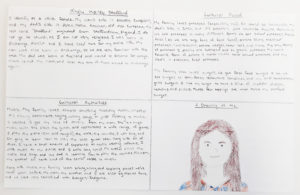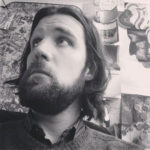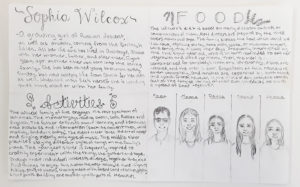This post was written by NCTE member Adam Mackie.
In the Anchorage school district, where I teach ninth- and twelfth-grade English language arts at West Anchorage High School, the reading of memoirs, such as Elie Wiesel’s Night, happens year after year (#nevershallweforget).
Reading and analytically responding to literature, whether memoir or otherwise, has been easy enough for me over the years. It’s the teaching of culturally responsive writing to students for real life, authentic, audiences that has posed a greater challenge, along with finding creative inroads to teaching texts like Homer’s Odyssey (or mythology in general).
Here I outline some approaches I’ve found effective.
Culture Cards
One way of teaching memoir that I’ve found effective is helping students write about themselves using what I call “Culture Cards.” (I’ve also written about Culture Cards for Edutopia in an article on social justice and teaching the classics: https://www.edutopia.org/article/social-justice-framing-classics).
Culture Cards are a way for students to write about their own cultural affiliation, favorite family foods, or simply foods a student likes, activities of interest (from traditional Alaska Native dance to popular music), and provide a visual self-representation. I also have students sum up their whole life into the popular Hemingway-style six-word memoir and further write about an even more developed personal memory or defining moment from childhood.
Typically, we use 5″ x 7″ index cards, front and back. I have students fold the card to create four quadrants or boxes. In the top left box of the blank side of the card, students write their name and cultural affiliation; in the top right box, students write foods of cultural interest; in the bottom left box students write activities significant to them; and in the bottom box right students provide the visual self-representation. On the back, and on the lined side of the card, students write the six-word memoir followed by the personal story, memory, or snapshot.
Culture Cards are one way students begin to introduce themselves culturally and write about themselves on a culturally responsive and critical level. I’ve also worked with multiple local storytelling organizations in Alaska to help facilitate the telling of personal memoirs and stories, including Alaska Teen Media Institute (ATMI) and Story Works Alaska.


Hero Stories
One year, I invited ATMI into a ninth-grade Honors English class to help students tell West High Hero Stories in response to Homer’s Odyssey. Students wrote 500-word accounts of a time where they acted heroically and were required to allude to the text of The Odyssey in some fashion.
In preparation for West High Hero Stories, I drew upon an activity I helped design with the Alaska Writing Project we titled #reverbwriting.
The idea of #reverbwriting is steeped in the idea that as writers, teacher researchers, and teacher leaders we possess the power to reverberate positive messages like a radio tower. The reverberation may start in our small, microcosmic school buildings. From there, however, writers and teachers alike possess the power to send reverberating signals out on the district-wide level, on state-wide levels, on national-levels (like writing blogs for NCTE), and beyond.
In my classroom #reverbwriting activity, students are asked a simple question: What does it mean to be heroic? Students answer the question on 3″ x 5″ cards, then collectively write their messages on a large piece of butcher paper with markers (or what I call a “classroom scroll”). Next students use a computer with an audio software program, such as GarageBand or Audacity, to record their message, saying they are heroic, creating what we call a “digital scroll.”
In the conception of #reverbwriting, it was important that students wrote multimodally—in both traditional ways (pen, pencil, paper) as well as 21st century, digital forms. Prior to offering #reverbwriting in my classroom, I teamed with the Alaska Writing Project to provide #reverbwriting to the community at the Anchorage Museum with New Year’s theme and focus.
In mythology, Joseph Campbell’s Hero’s Journey continues to be a useful model. I use it to show students an age-old narrative structure that lends itself to effectively writing about one’s own life in myriad formats, from filmmaking to writing a college narrative. Story Works Alaska joined me last spring to walk students through critically acclaimed storytelling techniques. One year, a colleague and I attempted to model how the Hero’s Journey could be used in writing for graduating students by writing a column for the local newspaper.
My Name
In addition to teaching 9th grade world literature and mythology to juniors and seniors, I also teach struggling readers in a Reading Apprenticeship course as well as juniors and seniors looking to fulfill an English elective with World or Classical Mythology. In the Reading Apprenticeship course, students have written “My Name” pieces exploring the depths of their own name in response to an excerpt from Sandra Cisneros’ House on Mango Street. Here I find writing alongside students, writing a memoir of my own (to my own name), indispensable.
The more I can show students that I’m a student of the discipline too, the better!
Whether it’s getting students to introduce themselves and write about their own culture, to connect to a text like Homer’s Odyssey with their own personal story, or to try to see themselves on a monomythic heroic journey of epic proportions, I feel a responsibility as an ELA teacher to get students writing for living and breathing audiences. As challenging or as tough as it may be in any given year, I’m committed to the task and invite others to write (and keep writing) creative memoirs of their own.

Adam Mackie teaches mythology, world literature, reading, and writing courses at West Anchorage High School in Anchorage, Alaska, as well as literacies and poetry courses at the University of Alaska Anchorage. He loves going on epic adventures with his two children, Noah and Hazel, and his wife, Margaret.


